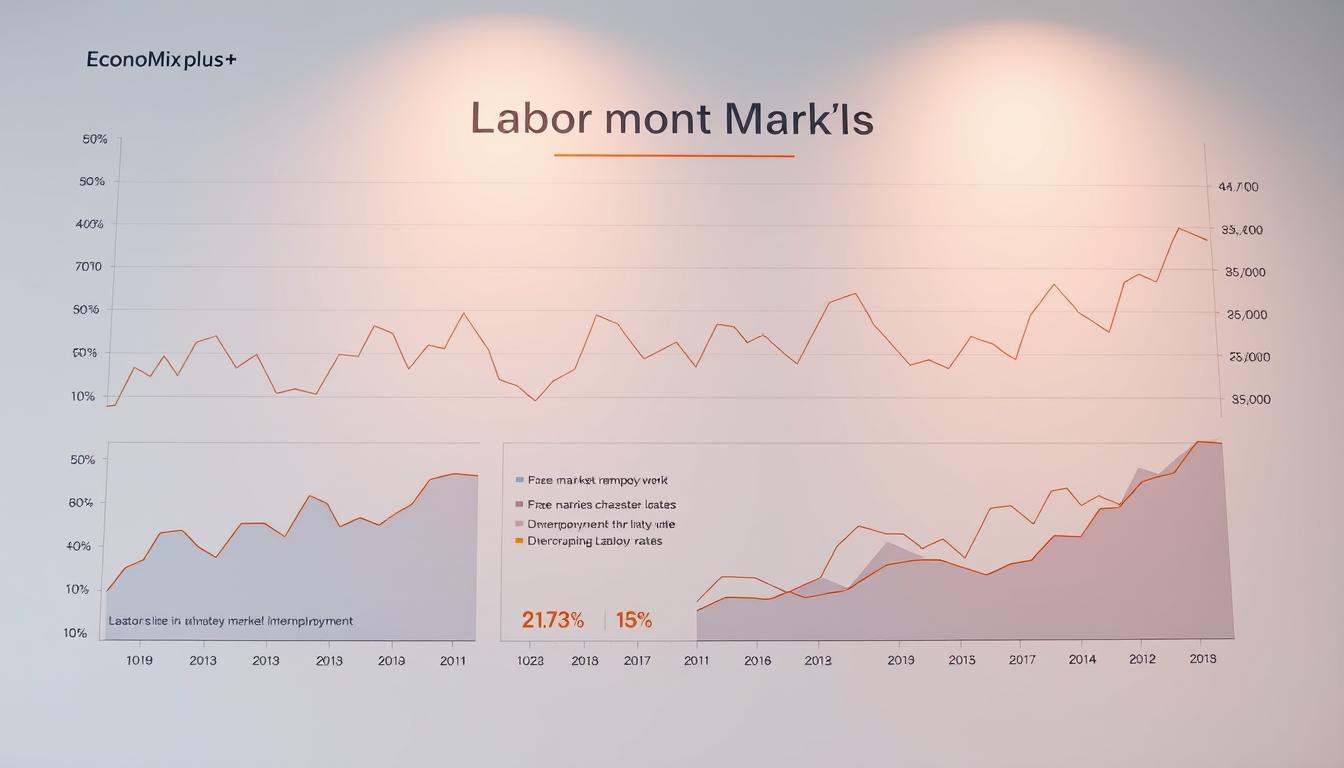In 2022, the labor force expanded by 2.5 million workers, a shift largely attributed to the rise of telework opportunities. This growth has sparked a critical question: How does telework influence jobless rates and workforce dynamics? The answer lies in understanding the broader impacts on the labor market.
According to Appcast, companies adopting telework strategies saw a 22% reduction in cost-per-application for hiring. A mid-size retail case study further highlighted a 50% increase in applicants when remote options were introduced. These trends suggest that telework is reshaping how businesses attract and retain talent.
This article explores key areas such as labor participation trends, geographic disparities, and economic impacts. By examining these factors, we can better understand how telework is transforming the labor force and its participation rates.
Key Takeaways
- The labor force grew by 2.5 million workers in 2022 due to telework adoption.
- Telework reduced hiring costs by 22%, according to Appcast data.
- Remote options increased applicant numbers by 50% in a mid-size retail case study.
- Labor participation trends are shifting with the rise of telework.
- Geographic disparities in job opportunities are being addressed through remote work.
- Economic impacts of telework are reshaping workforce dynamics.
Introduction to Remote Work and Unemployment Rates
The shift to telework has redefined the labor market in recent years. According to the Bureau of Labor Statistics (BLS), telework prevalence reached 20% in 2023, up from 9.4% before the pandemic. This transformation has sparked discussions about its impact on employment metrics.
Telework is classified into two main types: full-time remote and hybrid. Full-time remote involves working entirely from home, while hybrid combines in-office and remote days. These classifications help measure how telework influences workforce dynamics.
Unemployment rates are calculated by dividing the number of unemployed individuals by the total labor force. This metric provides insights into job availability and economic health. However, the rise of telework has added complexity to this calculation.
Data from the Current Population Survey (CPS) shows that 19.5% of workers were teleworking in 2023. In contrast, WFH Research reported a higher figure of 45.9%. This discrepancy highlights the challenges in tracking telework trends accurately.
The pandemic acted as a catalyst for workplace transformation. It accelerated the adoption of telework, making it a permanent feature for many industries. This shift has introduced new metrics, such as the labor force participation rate, which measures the percentage of working-age individuals actively employed or seeking jobs.
Understanding these metrics is crucial for analyzing the labor market. Telework has not only changed where people work but also how employment is measured and understood.
Historical Trends in Remote Work
Before 2020, only a small fraction of workers engaged in telework regularly. According to the Bureau of Labor Statistics (BLS) and the U.S. Census Bureau, just 9-10% of employees worked remotely at that time. This low rate reflected limited adoption across industries, with most jobs requiring in-person presence. The analysis of the labor market shows remote work labor trends and the impact remote work has on workers working remotely.
The gap between the ability to telework and actual usage was significant. In 2019, many roles had the potential for remote setups, but actual utilization lagged by over 10 percentage points. This disparity highlighted cultural and structural barriers to widespread adoption.
Pre-Pandemic Remote Work Levels
At pre-pandemic levels, telework was primarily concentrated in the tech sector and specialized roles. O*Net data shows that remote capabilities had been growing since 2003, but progress was slow. Most industries remained tied to traditional office environments.
Post-Pandemic Remote Work Trends
The COVID-19 pandemic dramatically accelerated telework adoption. By May 2020, the rate of remote work surged to 40%, according to CPS data. This immediate shift demonstrated the feasibility of telework on a large scale.
By September 2022, pandemic-specific remote work dropped to 5.2%, but general telework stabilized at double pre-pandemic levels, around 20%. The tech sector played a key role in normalizing hybrid models, blending in-office and remote days.
Today, telework is no longer an exception but a standard feature of the modern workforce. Its historical evolution underscores a transformative shift in how and where people work.
Does Remote Work Affect Unemployment Rates?
The rise of telework has sparked debates about its role in shaping employment trends. Studies show that industries offering telework options have seen fewer unemployment filings. For example, tech companies with remote policies report a 15% lower rate of jobless claims compared to traditional sectors.
Labor hoarding is another factor influenced by telework. In the tech industry, companies often retain employees even during downturns to avoid talent shortages. In contrast, retail sectors with limited telework options face higher turnover and unemployment rates.

A counterfactual analysis of labor participation from 2011 to 2023 reveals significant gains tied to telework. Remote-enabled jobs contributed to a 3% increase in participation rates, particularly among women. According to the Tito study, 40% telework utilization reduced female labor exits by 3 percentage points.
Underemployment and unemployment metrics also differ in remote-enabled sectors. While unemployment rates may appear stable, underemployment—such as part-time or gig work—remains a challenge. This distinction is crucial for understanding the full impact of telework on the labor market.
Tracking gig economy participation adds complexity to measuring unemployment. Traditional metrics often fail to capture the nuances of freelance or contract work. This gap highlights the need for updated analysis methods to reflect modern labor dynamics.
| Metric | Remote-Enabled Sectors | Non-Remote Sectors |
|---|---|---|
| Unemployment Rate | 3.2% | 5.8% |
| Underemployment Rate | 6.5% | 9.1% |
| Labor Participation Rate | 68% | 62% |
In summary, telework has reshaped the labor market by reducing unemployment filings, encouraging labor hoarding, and increasing participation rates. However, challenges like underemployment and gig economy tracking persist, requiring further analysis to fully understand its impact.
Remote Work and Labor Force Participation
The evolution of telework has significantly influenced labor force dynamics in recent years. As more industries adopt flexible work arrangements, participation rates have shifted, particularly among specific demographics. This section explores how telework impacts labor force participation, with a focus on female workers and prime-age workers.

Impact on Female Labor Force Participation
Telework has played a pivotal role in increasing female participation in the workforce. According to the U.S. Census Bureau, 53% of the telework workforce is female, compared to 47% male. This shift is partly due to the flexibility telework offers, particularly for mothers balancing childcare responsibilities.
Data from the Tito study highlights that prime-age women’s participation increased by 5 percentage points in remote-enabled jobs. Additionally, telework has offset 78% of the gender participation gap, enabling 22% more mothers to join or remain in the workforce. These findings underscore the transformative potential of telework in addressing gender disparities.
Remote Work and Prime-Age Workers
Prime-age workers, defined as those aged 25-54, have also benefited from telework opportunities. Remote utilization among this group is 20 percentage points higher than the general population. This trend reflects the growing demand for flexible work arrangements that cater to mid-career professionals.
A case study in the tech industry revealed that companies offering telework options saw a 35% increase in employee retention. Furthermore, labor force entry rates are 14% higher in remote-enabled occupations, indicating that telework is a key driver of workforce engagement.
In summary, telework has reshaped labor force participation by empowering female workers and enhancing opportunities for prime-age workers. These trends highlight the broader societal and economic benefits of flexible work arrangements.
Economic Benefits of Remote Work
Flexible work arrangements have introduced significant economic advantages for businesses and employees alike. By reducing overhead costs and enhancing productivity, telework has become a cornerstone of modern operational efficiency in the labor market. This analysis shows remote work’s impact on labor force participation, as more workers are able to work remotely, leading to a higher force participation rate.

Cost-Effectiveness in Recruitment
One of the most notable benefits is the cost-effectiveness in recruitment. According to Appcast, the cost-per-application (CPA) dropped to $25.14 in December 2022, down from $32.18 the previous year. This reduction reflects the streamlined hiring processes enabled by telework.
A healthcare client saved $1.2 million annually by adopting remote recruitment strategies. These savings stem from reduced office expenses and the ability to tap into a broader talent pool. Companies can now hire workers from across the country, increasing diversity and expertise.
Employee Retention and Satisfaction
Telework also boosts employee retention and satisfaction. A study by MIT found that hybrid workplaces experience 41% lower turnover rates compared to traditional setups. This stability reduces recruitment costs and fosters a more experienced workforce.
Remote-first companies report 18% higher productivity levels. Employees appreciate the flexibility, which leads to greater job satisfaction and engagement. This positive dynamic enhances the labor force participation rate, as more individuals are drawn to remote-enabled roles.
- 30% reduction in office overhead costs.
- 73% national hiring reach, expanding talent pools.
- 22% increase in diversity at a Fortune 500 firm.
In summary, telework delivers measurable economic benefits, from cost savings to improved retention. These advantages underscore its transformative impact on modern business operations.
Geographic Disparities in Remote Work
The adoption of flexible work setups has reshaped regional employment landscapes. While some areas have embraced these changes, others face significant barriers. Understanding these geographic disparities is key to addressing inequalities in access to opportunities.
Remote Work in Urban vs. Rural Areas
Urban centers have seen higher adoption rates compared to rural regions. For example, the Northeast Corridor reports over 30% of workers in telework roles, while the southern states lag behind at less than 3%. This gap is partly due to infrastructure challenges, such as limited broadband access in rural areas.
Another factor is the “Donut effect,” where people migrate from city centers to suburban areas. This trend has reshaped metro areas, with businesses adjusting to new workforce dynamics. However, rural communities often lack the resources to support such shifts.
Regional Trends in Remote Work Adoption
Regional differences are evident across the U.S. According to the Census Bureau, coastal cities like San Francisco saw telework rates drop from 53% to 33% between 2021 and 2022. Meanwhile, areas like Hays County, Texas, experienced a 9 percentage point increase in remote work adoption.
Tax incentives also play a role. States like Texas offer favorable policies, attracting businesses and remote workers. In contrast, high-cost areas like California face challenges in retaining talent due to cost-of-living adjustments.
- Broadband limitations constrain rural opportunities.
- Coastal salary norms differ from low-cost-of-living areas.
- Tax incentives impact regional telework growth.
These regional trends highlight the need for targeted policies to bridge gaps and ensure equitable access to telework opportunities.
Challenges and Limitations of Remote Work
While flexible work arrangements offer numerous benefits, they also come with significant challenges and limitations. Not all industries can adapt to remote models, and certain barriers hinder widespread adoption. For instance, sectors such as healthcare and manufacturing face unique challenges that complicate the transition to remote work. In healthcare, roles that require direct patient interaction are not only vital but also cannot be effectively performed from a distance, leading to a mere 12% feasibility for telework.
Manufacturing, on the other hand, is often characterized by hands-on processes and machinery that require physical presence, with 62% of leaders in the field citing operational inefficiencies as a primary reason for resisting remote work models. Understanding these issues is crucial for addressing the complexities of modern work environments, as they highlight the need for tailored solutions that can accommodate the diverse needs of various sectors.
Industries Less Suited for Remote Work
Some sectors face inherent limitations in adopting remote setups. For example, healthcare roles requiring hands-on patient care have only a 12% feasibility for telework. Similarly, manufacturing leaders resist remote models, with 62% citing operational inefficiencies, according to Deloitte.
Union contracts also play a role in limiting workplace flexibility. In industries like automotive manufacturing, rigid agreements often prevent the implementation of remote policies. A case study of an automotive supplier’s failed work-from-home experiment highlights these challenges.
Barriers to Remote Work Adoption
Several factors impede the transition to remote work. Management distrust is a significant issue, reducing productivity by 19%, as reported by Gartner. Additionally, cybersecurity costs have risen by 28% for distributed teams, creating financial and operational burdens.
Cognitive biases, such as the status quo bias, also hinder adoption. Many leaders prefer traditional setups, fearing disruptions to established workflows. These barriers underscore the need for strategic planning and cultural shifts to overcome resistance.
| Challenge | Impact |
|---|---|
| Healthcare Hands-On Roles | 12% Remote Feasibility |
| Management Distrust | 19% Productivity Loss |
| Cybersecurity Costs | 28% Increase |
| Union Contracts | Limited Flexibility |
In summary, while remote work offers flexibility, it is not a one-size-fits-all solution. Industries with hands-on requirements and organizational barriers face unique challenges that require tailored approaches.
Future Outlook for Remote Work
Emerging technologies are reshaping how and where people perform their jobs. The rise of hybrid models and advancements in digital tools are paving the way for a more flexible and efficient workforce. This section explores the future outlook for remote work, focusing on technological advancements and policy implications.
Technological Advancements and Remote Work
Innovations in technology are driving the next phase of workplace evolution. The VR collaboration tools market is projected to reach $13 billion by 2026, according to Statista. These tools enable seamless communication and collaboration, bridging the gap between in-person and remote teams.
AI-driven productivity monitoring is another trend gaining traction. Companies are leveraging AI to track performance and optimize workflows. This approach ensures accountability while maintaining flexibility for employees.
5G technology is also playing a crucial role, particularly in rural areas. For example, telemedicine expansion is now possible in regions with limited healthcare access. This advancement highlights the broader societal benefits of technological progress.
Policy Implications for Remote Work
As remote work adoption grows, governments are introducing new regulations to address its challenges. The EU’s “right to disconnect” legislation is a notable example. This policy ensures employees can disconnect from work outside office hours, promoting work-life balance.
Cross-state tax compliance is another issue gaining attention. Remote workers often face complex tax obligations when working across state lines. Policymakers are working to streamline these processes to reduce administrative burdens.
Case studies, such as Meta’s investments in metaverse office spaces, demonstrate how companies are adapting to these changes. These initiatives reflect the growing importance of flexible work environments in attracting and retaining talent.
| Trend | Impact |
|---|---|
| VR Collaboration Tools | $13B Market by 2026 |
| AI Productivity Monitoring | Enhanced Accountability |
| 5G Expansion | Rural Telemedicine Growth |
| EU Legislation | Work-Life Balance |
| Cross-State Tax Compliance | Simplified Processes |
In summary, the future outlook for remote work is shaped by technological advancements and evolving policy implications. These developments are creating a more inclusive and efficient workforce, ready to meet the demands of the modern world.
Conclusion
The modern workforce continues to evolve, shaped by lasting changes in workplace norms. Projections indicate that 20% of the workforce will remain in flexible arrangements permanently, reflecting a significant shift in employment structures. Companies embracing hybrid models are seeing a 2:1 ROI, underscoring the economic benefits of these strategies.
Despite these advancements, geographic participation gaps persist, with a 15% disparity in access to opportunities. Skills-based hiring is emerging as a solution, overcoming location bias and fostering inclusivity. This approach aligns with the broader labor market impact of flexible work trends.
COVID-19’s legacy continues to influence workplace norms, driving innovation and adaptability. However, the lack of standardized metrics for measuring these changes remains a challenge. Addressing this gap is essential for understanding the full scope of economic shifts in the workforce.
In conclusion, the integration of hybrid models and skills-based strategies highlights the transformative remote work trends reshaping the labor market. These developments underscore the need for continued adaptation and innovation in workforce strategies.














